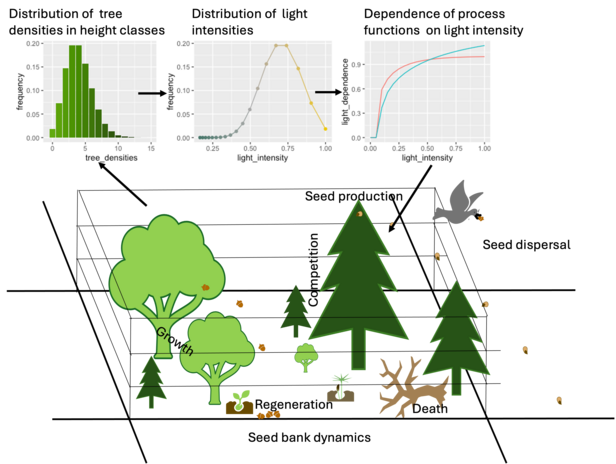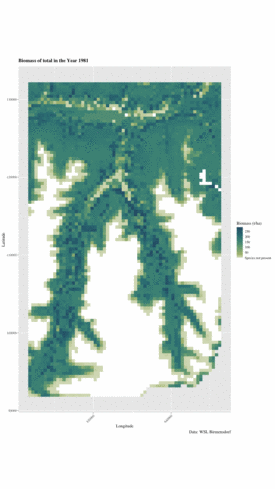
Core model ¶
TreeMig: modelling spatio-temporal forest dynamics from stand to continental scale ¶
The TreeMig core model is described here, and various further developments and applications are listed.
Contents ¶
Frame ¶
The development, extension and application of TreeMig is a core project of the WSL groups Dynamic Makroecology and Plant Regeneration Ecology.
TreeMig approach ¶
We developed the TreeMig model (Lischke et al., 2006), a spatially explicit and linked forest landscape model originally based on a forest gap model (Lischke et al., 1998), which takes additionally into account tree species migration. In each cell (sidelength from 25m to 1km) of a rectangular grid, forest dynamics is simulated at the species level, including environment dependent reproduction, growth, competition, and mortality, and between-cell seed dispersal which allows the simulation of migration (Lischke et al., 2006). Within-cell vertical and horizontal structure is depicted by frequency distributions of tree density in height classes and therefore light attenuation.
A detailed documentation of the model can be found here.

Further model developments ¶
Over the years, the TreeMig model has been continuously improved and further developed to enable new applications and optimally answer scientific questions. Below is a list of the most important improvements:
Optimizing by optional Fast Fourier Transformation for seed dispersal (according to Lehsten et al, 2019) and by parallelization by simulating overlapping stripes of the simulation domain on different processors
Coupling with land abandonment (Rickebusch et al., 2007); avalanche dynamics in high alpine regions (Zurbriggen et al., 2014; Teich et al., 2012); rockfall dynamics (Moos & Lischke, 2022; Moos et al., 2021); hydrology, via phenology and leaf area (project FORHYCS; Speich et al. 2018a, 2018b, 2020)
Upscaling by deriving migration speeds from TreeMig simulations on a transect under various climatic, competitive and fragmentation conditions (Meier et al., 2012), simulating only representative grid cells for certain processes (Nabel & Lischke, 2013; Nabel, 2015)
Sensitivity to the formulation of climate input variability (Nabel et al., 2013,2014)
Applications ¶
First regional scale (50*50 cells each 25m*25m) tests, initialized with seeds only in the center cell show first a wavelike spread of the pioneer species, and for species with low seed production strong effects of stochastic seed dispersal. Competition plays a major role in shaping the pattern.
Several simulation studies with TreeMig on the local to country scale demonstrated that climate change and species migration can drastically affect composition and distribution of forests in past and in the future (Lischke, 2020).
Past
Simulations for the Holocene in the Valais region show a vivid dynamics of species composition, determined by succession and migration, which are triggered by immigration events and climate (Lischke, 2004, 2005; Lischke et al., 2006). In contrast, TreeMig simulations indicate that the afforestation (associated with a change in albedo and surface roughness) after a drastic temperature rise during the late-glacial is mostly driven by climate and positive feedbacks via nutrient dynamics and albedo for most species, initiating a successional pattern, which is later affected by the lagged immigration of Pinus (Lischke et al., 2013).
Current
TreeMig has also been applied to simulate climate change driven forest composition to interprete the spread of Quercus ilex in Western France during the last century (Delzon et al., 2013) and the feedback with avalanches in the Dischma-valley in Davos (Zurbriggen et al. 2014, Teich et al. 2012).
Future
Simulations in the boreal/arctic zone of Siberia with climate change indicate that migration of tree species lags the northward shift of their potential niches by several centuries (Epstein et al., 2007; Goetz et al., 2011; Lischke 2020), which has consequences for feedbacks to the climate system by changed albedo and carbon sequestration.
Other applications comprise landscape scale simulations of effects of climate change and disturbances in Switzerland, e.g. of avalanches (Petter et al., 2020), or rockfall (Moos et al., 2021).
Swiss-wide simulations with 200 m resolution driven by one climate change- and several scenarios for land-use change and migration point to strong climate and locally strong and overall moderate effects of land-use, competition and dispersal on species shifts (Lischke, 2020). The species shift upwards, and faster-migrating species (e.g. Larch and Spruce) can temporarily block slower-migrating species (Stone pine and Beech). Such a blocking was also found in regional simulations of treeline shifts (Scherrer et al., 2020)
